Comprehensive Analysis of Strategic HRM at CIT: A Report
VerifiedAdded on 2020/03/02
|21
|6021
|33
Report
AI Summary
This report provides a detailed analysis of the strategic human resource management (HRM) practices at Complete IT (CIT), a UK-based IT support services company. It begins with an introduction to HRM and background information on CIT, followed by an examination of its HR strategy, including the application of Strategic Human Resource Management (SHRM) and Human Resource Management Systems (HRMS). The report explores relevant models and theories of SHRM, such as the universalistic technique, fit or contingency approach, and configurational perspective. It highlights the importance of HRM in CIT, covering aspects like recruitment, training, performance assessments, and employee relations. The assessment of various HRM structures, including the Harvard analytical framework and Ulrich's multiple role approach, is also presented. The report further discusses the formulation, implementation, and application of HR strategies within CIT, offering recommendations for enhancing the company's strategic HRM. The conclusion summarizes the key findings and insights regarding CIT's approach to managing its human resources.
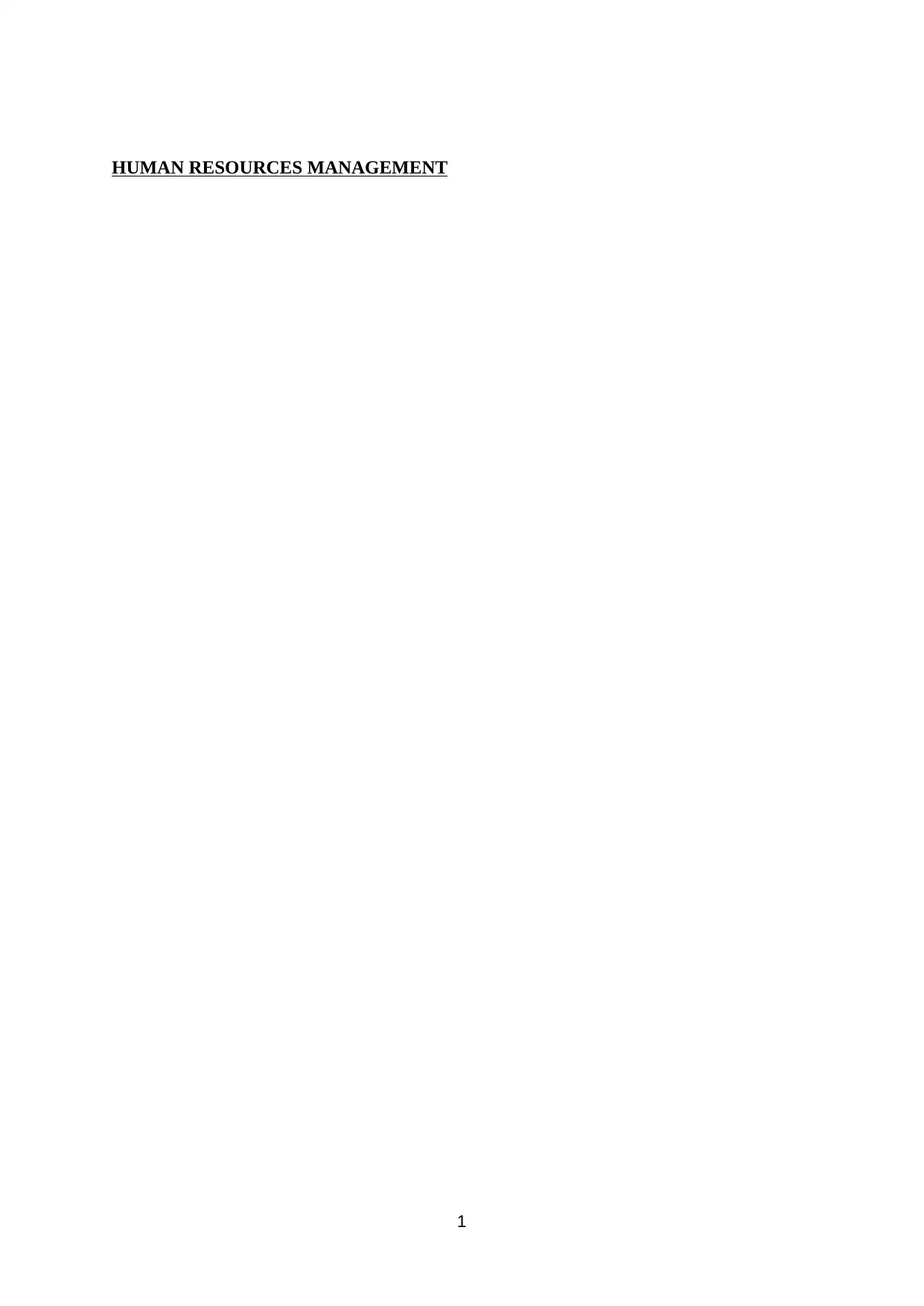
HUMAN RESOURCES MANAGEMENT
1
1
Paraphrase This Document
Need a fresh take? Get an instant paraphrase of this document with our AI Paraphraser
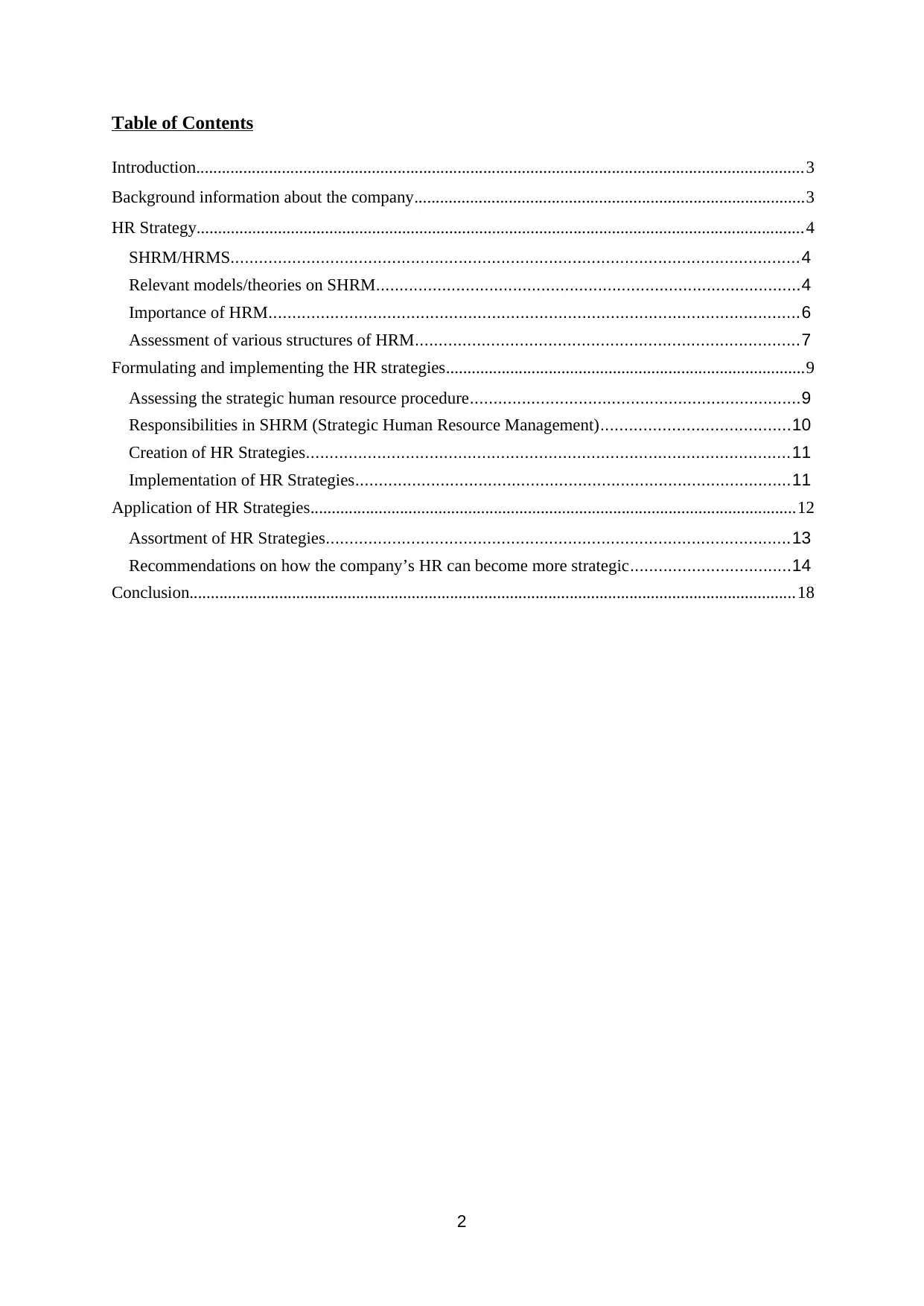
Table of Contents
Introduction..............................................................................................................................................3
Background information about the company...........................................................................................3
HR Strategy..............................................................................................................................................4
SHRM/HRMS........................................................................................................................4
Relevant models/theories on SHRM..........................................................................................4
Importance of HRM................................................................................................................6
Assessment of various structures of HRM.................................................................................7
Formulating and implementing the HR strategies....................................................................................9
Assessing the strategic human resource procedure......................................................................9
Responsibilities in SHRM (Strategic Human Resource Management)........................................10
Creation of HR Strategies......................................................................................................11
Implementation of HR Strategies............................................................................................11
Application of HR Strategies..................................................................................................................12
Assortment of HR Strategies..................................................................................................13
Recommendations on how the company’s HR can become more strategic..................................14
Conclusion..............................................................................................................................................18
2
Introduction..............................................................................................................................................3
Background information about the company...........................................................................................3
HR Strategy..............................................................................................................................................4
SHRM/HRMS........................................................................................................................4
Relevant models/theories on SHRM..........................................................................................4
Importance of HRM................................................................................................................6
Assessment of various structures of HRM.................................................................................7
Formulating and implementing the HR strategies....................................................................................9
Assessing the strategic human resource procedure......................................................................9
Responsibilities in SHRM (Strategic Human Resource Management)........................................10
Creation of HR Strategies......................................................................................................11
Implementation of HR Strategies............................................................................................11
Application of HR Strategies..................................................................................................................12
Assortment of HR Strategies..................................................................................................13
Recommendations on how the company’s HR can become more strategic..................................14
Conclusion..............................................................................................................................................18
2
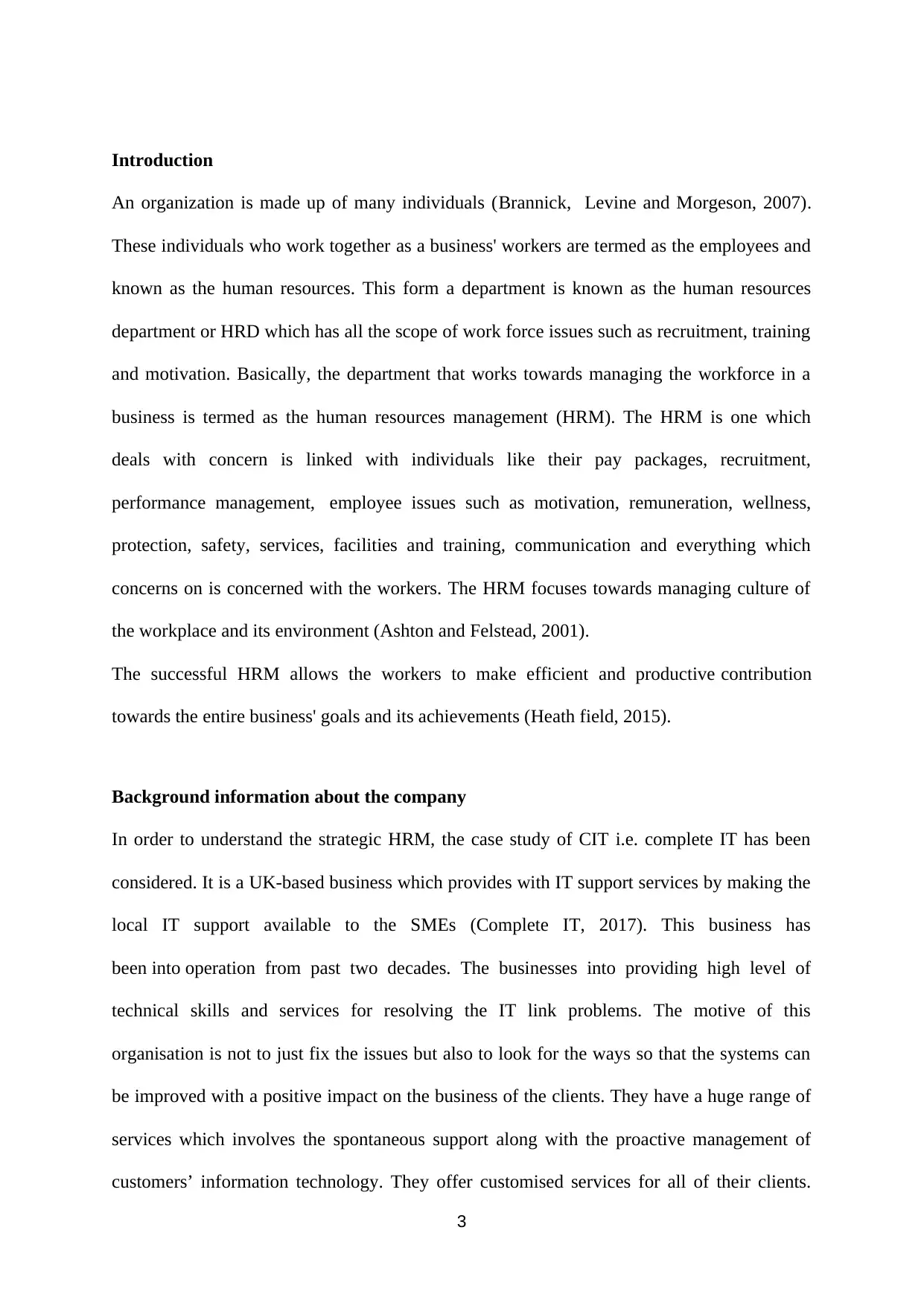
Introduction
An organization is made up of many individuals (Brannick, Levine and Morgeson, 2007).
These individuals who work together as a business' workers are termed as the employees and
known as the human resources. This form a department is known as the human resources
department or HRD which has all the scope of work force issues such as recruitment, training
and motivation. Basically, the department that works towards managing the workforce in a
business is termed as the human resources management (HRM). The HRM is one which
deals with concern is linked with individuals like their pay packages, recruitment,
performance management, employee issues such as motivation, remuneration, wellness,
protection, safety, services, facilities and training, communication and everything which
concerns on is concerned with the workers. The HRM focuses towards managing culture of
the workplace and its environment (Ashton and Felstead, 2001).
The successful HRM allows the workers to make efficient and productive contribution
towards the entire business' goals and its achievements (Heath field, 2015).
Background information about the company
In order to understand the strategic HRM, the case study of CIT i.e. complete IT has been
considered. It is a UK-based business which provides with IT support services by making the
local IT support available to the SMEs (Complete IT, 2017). This business has
been into operation from past two decades. The businesses into providing high level of
technical skills and services for resolving the IT link problems. The motive of this
organisation is not to just fix the issues but also to look for the ways so that the systems can
be improved with a positive impact on the business of the clients. They have a huge range of
services which involves the spontaneous support along with the proactive management of
customers’ information technology. They offer customised services for all of their clients.
3
An organization is made up of many individuals (Brannick, Levine and Morgeson, 2007).
These individuals who work together as a business' workers are termed as the employees and
known as the human resources. This form a department is known as the human resources
department or HRD which has all the scope of work force issues such as recruitment, training
and motivation. Basically, the department that works towards managing the workforce in a
business is termed as the human resources management (HRM). The HRM is one which
deals with concern is linked with individuals like their pay packages, recruitment,
performance management, employee issues such as motivation, remuneration, wellness,
protection, safety, services, facilities and training, communication and everything which
concerns on is concerned with the workers. The HRM focuses towards managing culture of
the workplace and its environment (Ashton and Felstead, 2001).
The successful HRM allows the workers to make efficient and productive contribution
towards the entire business' goals and its achievements (Heath field, 2015).
Background information about the company
In order to understand the strategic HRM, the case study of CIT i.e. complete IT has been
considered. It is a UK-based business which provides with IT support services by making the
local IT support available to the SMEs (Complete IT, 2017). This business has
been into operation from past two decades. The businesses into providing high level of
technical skills and services for resolving the IT link problems. The motive of this
organisation is not to just fix the issues but also to look for the ways so that the systems can
be improved with a positive impact on the business of the clients. They have a huge range of
services which involves the spontaneous support along with the proactive management of
customers’ information technology. They offer customised services for all of their clients.
3
⊘ This is a preview!⊘
Do you want full access?
Subscribe today to unlock all pages.

Trusted by 1+ million students worldwide
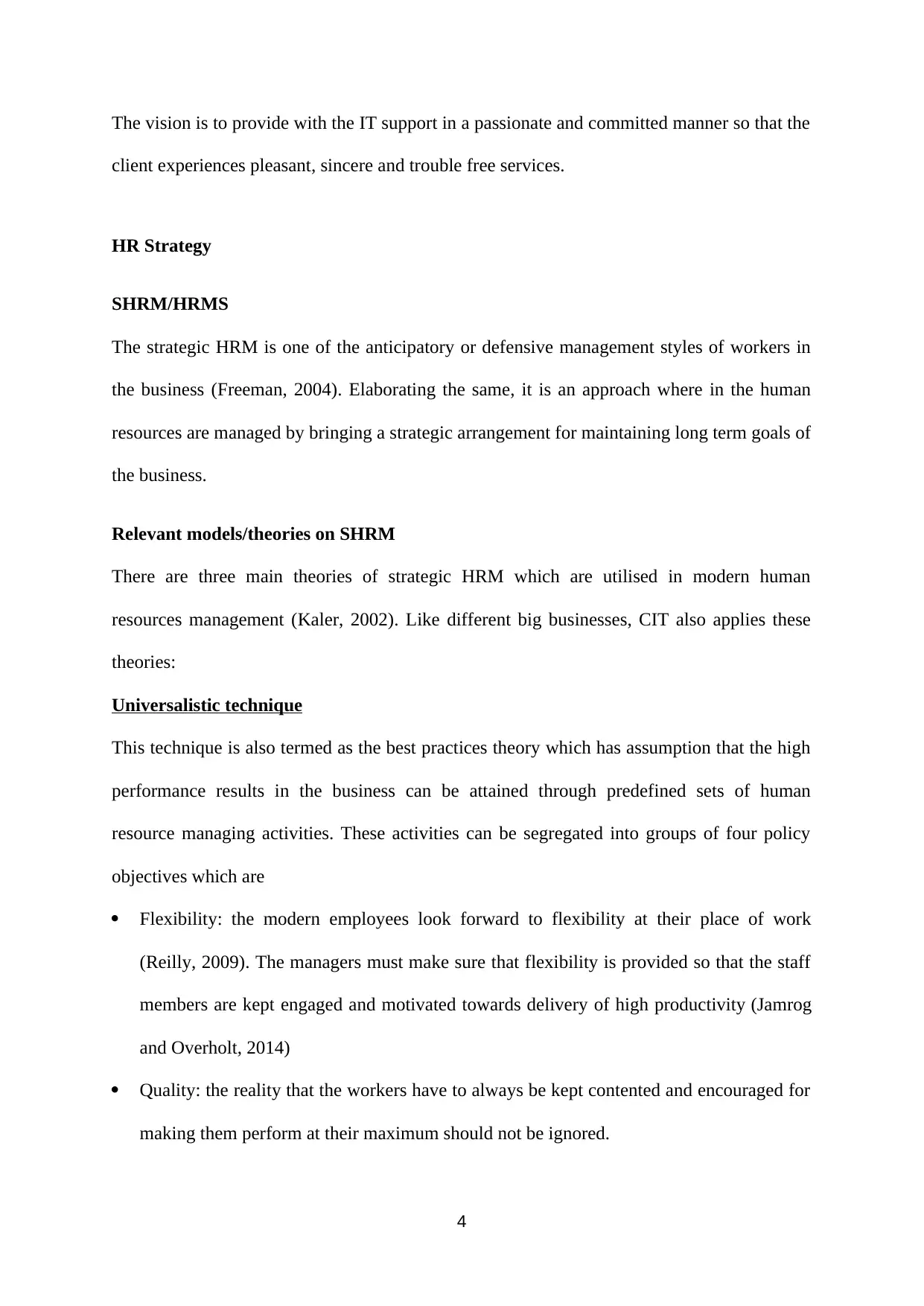
The vision is to provide with the IT support in a passionate and committed manner so that the
client experiences pleasant, sincere and trouble free services.
HR Strategy
SHRM/HRMS
The strategic HRM is one of the anticipatory or defensive management styles of workers in
the business (Freeman, 2004). Elaborating the same, it is an approach where in the human
resources are managed by bringing a strategic arrangement for maintaining long term goals of
the business.
Relevant models/theories on SHRM
There are three main theories of strategic HRM which are utilised in modern human
resources management (Kaler, 2002). Like different big businesses, CIT also applies these
theories:
Universalistic technique
This technique is also termed as the best practices theory which has assumption that the high
performance results in the business can be attained through predefined sets of human
resource managing activities. These activities can be segregated into groups of four policy
objectives which are
Flexibility: the modern employees look forward to flexibility at their place of work
(Reilly, 2009). The managers must make sure that flexibility is provided so that the staff
members are kept engaged and motivated towards delivery of high productivity (Jamrog
and Overholt, 2014)
Quality: the reality that the workers have to always be kept contented and encouraged for
making them perform at their maximum should not be ignored.
4
client experiences pleasant, sincere and trouble free services.
HR Strategy
SHRM/HRMS
The strategic HRM is one of the anticipatory or defensive management styles of workers in
the business (Freeman, 2004). Elaborating the same, it is an approach where in the human
resources are managed by bringing a strategic arrangement for maintaining long term goals of
the business.
Relevant models/theories on SHRM
There are three main theories of strategic HRM which are utilised in modern human
resources management (Kaler, 2002). Like different big businesses, CIT also applies these
theories:
Universalistic technique
This technique is also termed as the best practices theory which has assumption that the high
performance results in the business can be attained through predefined sets of human
resource managing activities. These activities can be segregated into groups of four policy
objectives which are
Flexibility: the modern employees look forward to flexibility at their place of work
(Reilly, 2009). The managers must make sure that flexibility is provided so that the staff
members are kept engaged and motivated towards delivery of high productivity (Jamrog
and Overholt, 2014)
Quality: the reality that the workers have to always be kept contented and encouraged for
making them perform at their maximum should not be ignored.
4
Paraphrase This Document
Need a fresh take? Get an instant paraphrase of this document with our AI Paraphraser
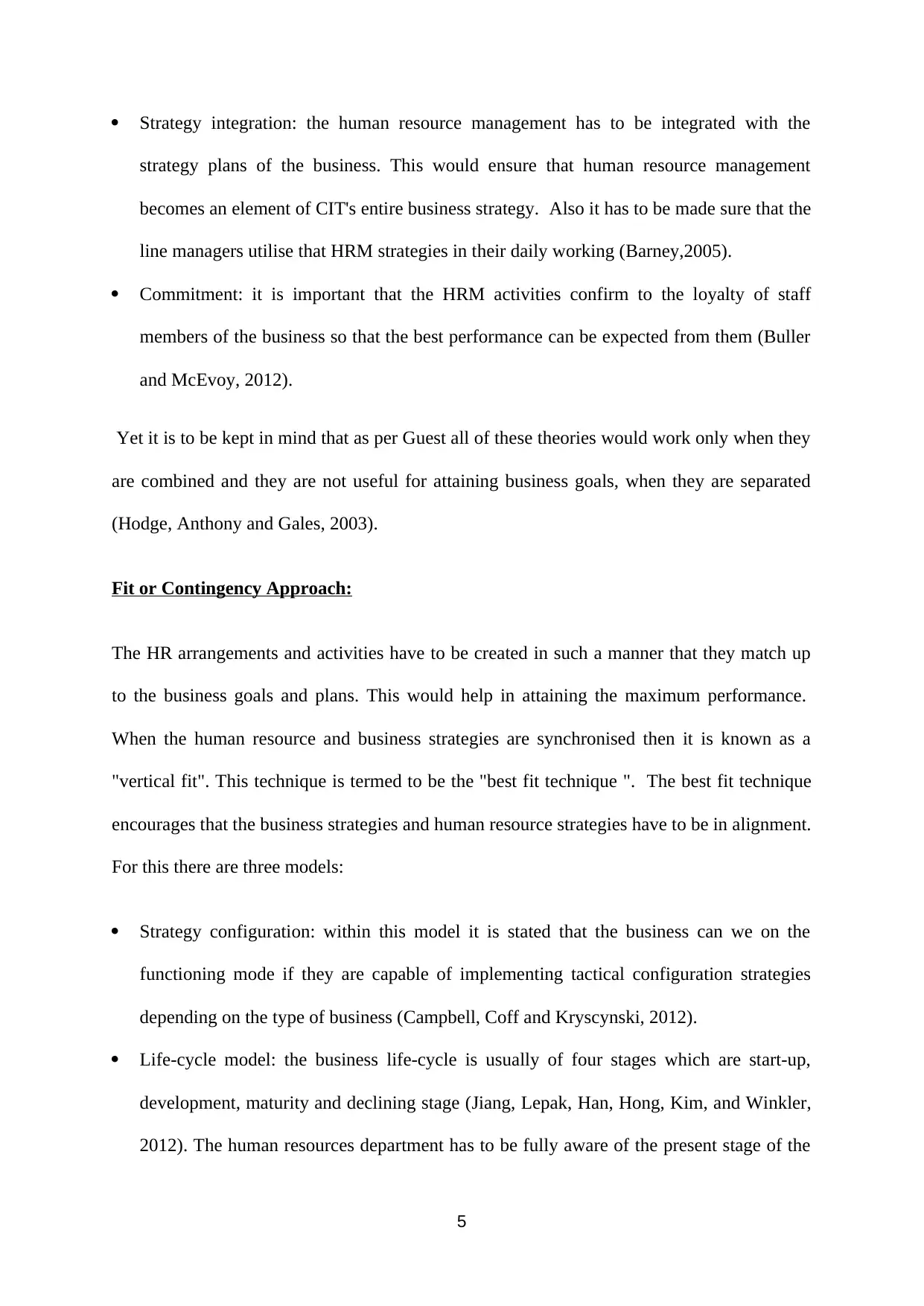
Strategy integration: the human resource management has to be integrated with the
strategy plans of the business. This would ensure that human resource management
becomes an element of CIT's entire business strategy. Also it has to be made sure that the
line managers utilise that HRM strategies in their daily working (Barney,2005).
Commitment: it is important that the HRM activities confirm to the loyalty of staff
members of the business so that the best performance can be expected from them (Buller
and McEvoy, 2012).
Yet it is to be kept in mind that as per Guest all of these theories would work only when they
are combined and they are not useful for attaining business goals, when they are separated
(Hodge, Anthony and Gales, 2003).
Fit or Contingency Approach:
The HR arrangements and activities have to be created in such a manner that they match up
to the business goals and plans. This would help in attaining the maximum performance.
When the human resource and business strategies are synchronised then it is known as a
"vertical fit". This technique is termed to be the "best fit technique ". The best fit technique
encourages that the business strategies and human resource strategies have to be in alignment.
For this there are three models:
Strategy configuration: within this model it is stated that the business can we on the
functioning mode if they are capable of implementing tactical configuration strategies
depending on the type of business (Campbell, Coff and Kryscynski, 2012).
Life-cycle model: the business life-cycle is usually of four stages which are start-up,
development, maturity and declining stage (Jiang, Lepak, Han, Hong, Kim, and Winkler,
2012). The human resources department has to be fully aware of the present stage of the
5
strategy plans of the business. This would ensure that human resource management
becomes an element of CIT's entire business strategy. Also it has to be made sure that the
line managers utilise that HRM strategies in their daily working (Barney,2005).
Commitment: it is important that the HRM activities confirm to the loyalty of staff
members of the business so that the best performance can be expected from them (Buller
and McEvoy, 2012).
Yet it is to be kept in mind that as per Guest all of these theories would work only when they
are combined and they are not useful for attaining business goals, when they are separated
(Hodge, Anthony and Gales, 2003).
Fit or Contingency Approach:
The HR arrangements and activities have to be created in such a manner that they match up
to the business goals and plans. This would help in attaining the maximum performance.
When the human resource and business strategies are synchronised then it is known as a
"vertical fit". This technique is termed to be the "best fit technique ". The best fit technique
encourages that the business strategies and human resource strategies have to be in alignment.
For this there are three models:
Strategy configuration: within this model it is stated that the business can we on the
functioning mode if they are capable of implementing tactical configuration strategies
depending on the type of business (Campbell, Coff and Kryscynski, 2012).
Life-cycle model: the business life-cycle is usually of four stages which are start-up,
development, maturity and declining stage (Jiang, Lepak, Han, Hong, Kim, and Winkler,
2012). The human resources department has to be fully aware of the present stage of the
5
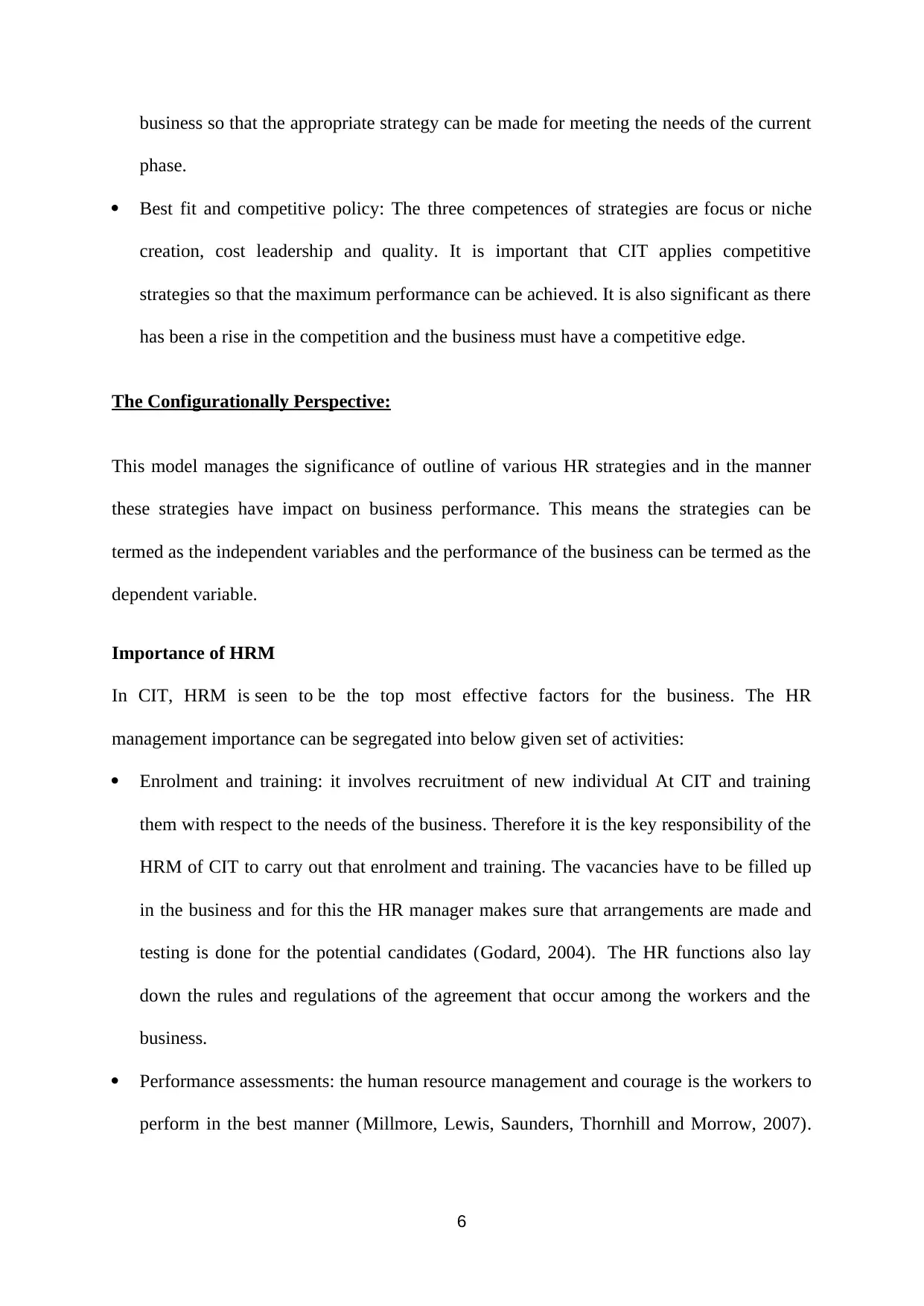
business so that the appropriate strategy can be made for meeting the needs of the current
phase.
Best fit and competitive policy: The three competences of strategies are focus or niche
creation, cost leadership and quality. It is important that CIT applies competitive
strategies so that the maximum performance can be achieved. It is also significant as there
has been a rise in the competition and the business must have a competitive edge.
The Configurationally Perspective:
This model manages the significance of outline of various HR strategies and in the manner
these strategies have impact on business performance. This means the strategies can be
termed as the independent variables and the performance of the business can be termed as the
dependent variable.
Importance of HRM
In CIT, HRM is seen to be the top most effective factors for the business. The HR
management importance can be segregated into below given set of activities:
Enrolment and training: it involves recruitment of new individual At CIT and training
them with respect to the needs of the business. Therefore it is the key responsibility of the
HRM of CIT to carry out that enrolment and training. The vacancies have to be filled up
in the business and for this the HR manager makes sure that arrangements are made and
testing is done for the potential candidates (Godard, 2004). The HR functions also lay
down the rules and regulations of the agreement that occur among the workers and the
business.
Performance assessments: the human resource management and courage is the workers to
perform in the best manner (Millmore, Lewis, Saunders, Thornhill and Morrow, 2007).
6
phase.
Best fit and competitive policy: The three competences of strategies are focus or niche
creation, cost leadership and quality. It is important that CIT applies competitive
strategies so that the maximum performance can be achieved. It is also significant as there
has been a rise in the competition and the business must have a competitive edge.
The Configurationally Perspective:
This model manages the significance of outline of various HR strategies and in the manner
these strategies have impact on business performance. This means the strategies can be
termed as the independent variables and the performance of the business can be termed as the
dependent variable.
Importance of HRM
In CIT, HRM is seen to be the top most effective factors for the business. The HR
management importance can be segregated into below given set of activities:
Enrolment and training: it involves recruitment of new individual At CIT and training
them with respect to the needs of the business. Therefore it is the key responsibility of the
HRM of CIT to carry out that enrolment and training. The vacancies have to be filled up
in the business and for this the HR manager makes sure that arrangements are made and
testing is done for the potential candidates (Godard, 2004). The HR functions also lay
down the rules and regulations of the agreement that occur among the workers and the
business.
Performance assessments: the human resource management and courage is the workers to
perform in the best manner (Millmore, Lewis, Saunders, Thornhill and Morrow, 2007).
6
⊘ This is a preview!⊘
Do you want full access?
Subscribe today to unlock all pages.

Trusted by 1+ million students worldwide
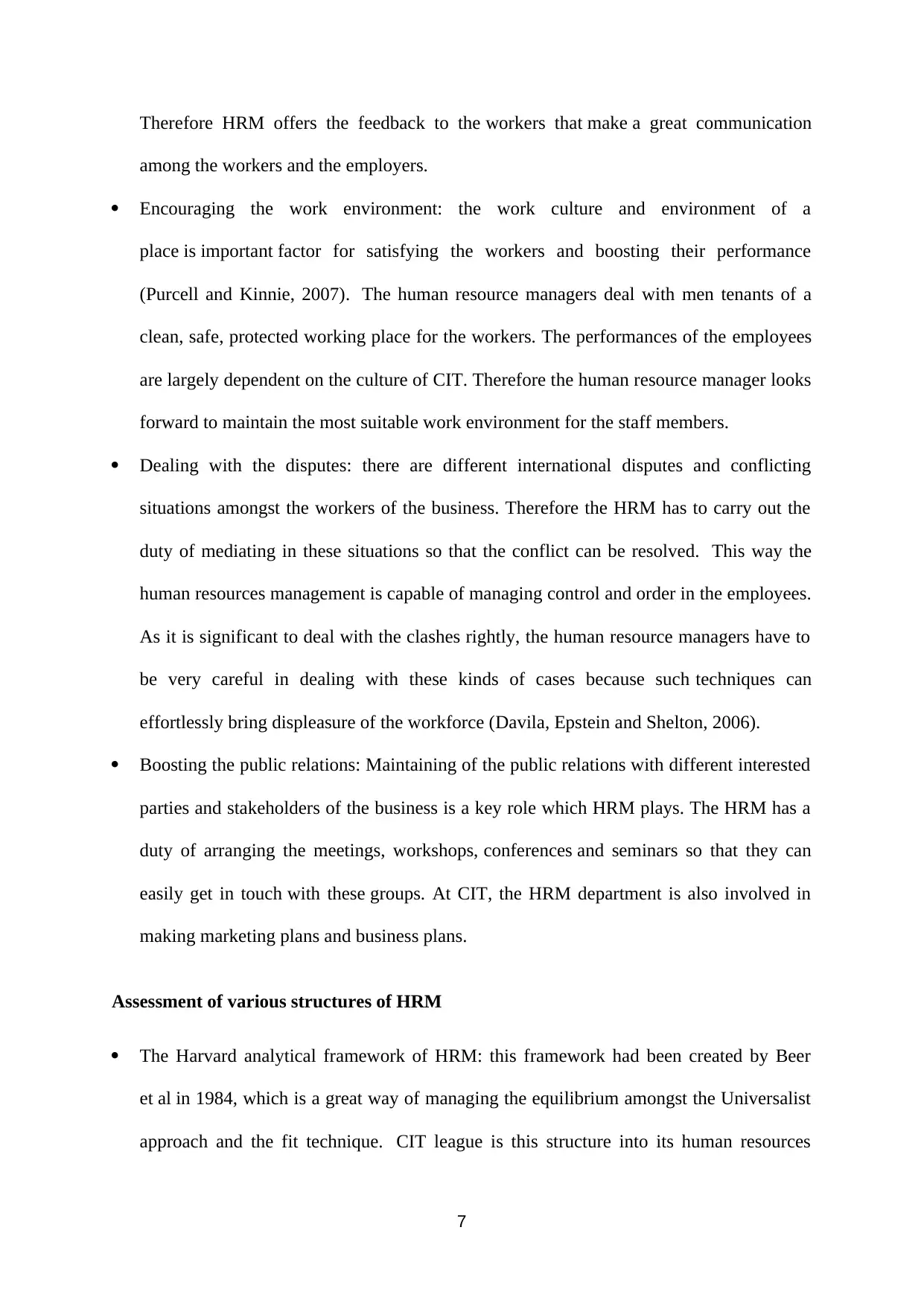
Therefore HRM offers the feedback to the workers that make a great communication
among the workers and the employers.
Encouraging the work environment: the work culture and environment of a
place is important factor for satisfying the workers and boosting their performance
(Purcell and Kinnie, 2007). The human resource managers deal with men tenants of a
clean, safe, protected working place for the workers. The performances of the employees
are largely dependent on the culture of CIT. Therefore the human resource manager looks
forward to maintain the most suitable work environment for the staff members.
Dealing with the disputes: there are different international disputes and conflicting
situations amongst the workers of the business. Therefore the HRM has to carry out the
duty of mediating in these situations so that the conflict can be resolved. This way the
human resources management is capable of managing control and order in the employees.
As it is significant to deal with the clashes rightly, the human resource managers have to
be very careful in dealing with these kinds of cases because such techniques can
effortlessly bring displeasure of the workforce (Davila, Epstein and Shelton, 2006).
Boosting the public relations: Maintaining of the public relations with different interested
parties and stakeholders of the business is a key role which HRM plays. The HRM has a
duty of arranging the meetings, workshops, conferences and seminars so that they can
easily get in touch with these groups. At CIT, the HRM department is also involved in
making marketing plans and business plans.
Assessment of various structures of HRM
The Harvard analytical framework of HRM: this framework had been created by Beer
et al in 1984, which is a great way of managing the equilibrium amongst the Universalist
approach and the fit technique. CIT league is this structure into its human resources
7
among the workers and the employers.
Encouraging the work environment: the work culture and environment of a
place is important factor for satisfying the workers and boosting their performance
(Purcell and Kinnie, 2007). The human resource managers deal with men tenants of a
clean, safe, protected working place for the workers. The performances of the employees
are largely dependent on the culture of CIT. Therefore the human resource manager looks
forward to maintain the most suitable work environment for the staff members.
Dealing with the disputes: there are different international disputes and conflicting
situations amongst the workers of the business. Therefore the HRM has to carry out the
duty of mediating in these situations so that the conflict can be resolved. This way the
human resources management is capable of managing control and order in the employees.
As it is significant to deal with the clashes rightly, the human resource managers have to
be very careful in dealing with these kinds of cases because such techniques can
effortlessly bring displeasure of the workforce (Davila, Epstein and Shelton, 2006).
Boosting the public relations: Maintaining of the public relations with different interested
parties and stakeholders of the business is a key role which HRM plays. The HRM has a
duty of arranging the meetings, workshops, conferences and seminars so that they can
easily get in touch with these groups. At CIT, the HRM department is also involved in
making marketing plans and business plans.
Assessment of various structures of HRM
The Harvard analytical framework of HRM: this framework had been created by Beer
et al in 1984, which is a great way of managing the equilibrium amongst the Universalist
approach and the fit technique. CIT league is this structure into its human resources
7
Paraphrase This Document
Need a fresh take? Get an instant paraphrase of this document with our AI Paraphraser
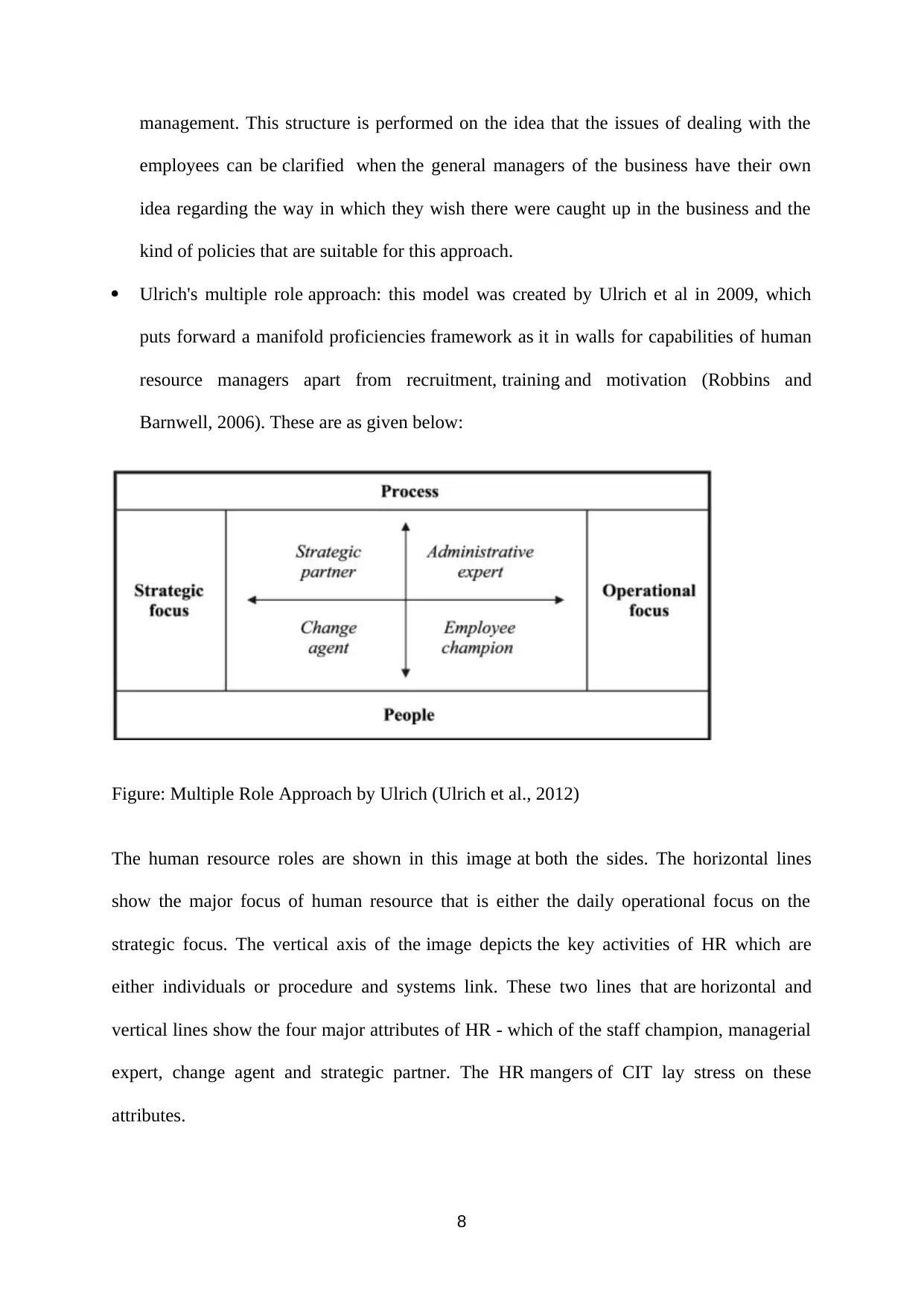
management. This structure is performed on the idea that the issues of dealing with the
employees can be clarified when the general managers of the business have their own
idea regarding the way in which they wish there were caught up in the business and the
kind of policies that are suitable for this approach.
Ulrich's multiple role approach: this model was created by Ulrich et al in 2009, which
puts forward a manifold proficiencies framework as it in walls for capabilities of human
resource managers apart from recruitment, training and motivation (Robbins and
Barnwell, 2006). These are as given below:
Figure: Multiple Role Approach by Ulrich (Ulrich et al., 2012)
The human resource roles are shown in this image at both the sides. The horizontal lines
show the major focus of human resource that is either the daily operational focus on the
strategic focus. The vertical axis of the image depicts the key activities of HR which are
either individuals or procedure and systems link. These two lines that are horizontal and
vertical lines show the four major attributes of HR - which of the staff champion, managerial
expert, change agent and strategic partner. The HR mangers of CIT lay stress on these
attributes.
8
employees can be clarified when the general managers of the business have their own
idea regarding the way in which they wish there were caught up in the business and the
kind of policies that are suitable for this approach.
Ulrich's multiple role approach: this model was created by Ulrich et al in 2009, which
puts forward a manifold proficiencies framework as it in walls for capabilities of human
resource managers apart from recruitment, training and motivation (Robbins and
Barnwell, 2006). These are as given below:
Figure: Multiple Role Approach by Ulrich (Ulrich et al., 2012)
The human resource roles are shown in this image at both the sides. The horizontal lines
show the major focus of human resource that is either the daily operational focus on the
strategic focus. The vertical axis of the image depicts the key activities of HR which are
either individuals or procedure and systems link. These two lines that are horizontal and
vertical lines show the four major attributes of HR - which of the staff champion, managerial
expert, change agent and strategic partner. The HR mangers of CIT lay stress on these
attributes.
8
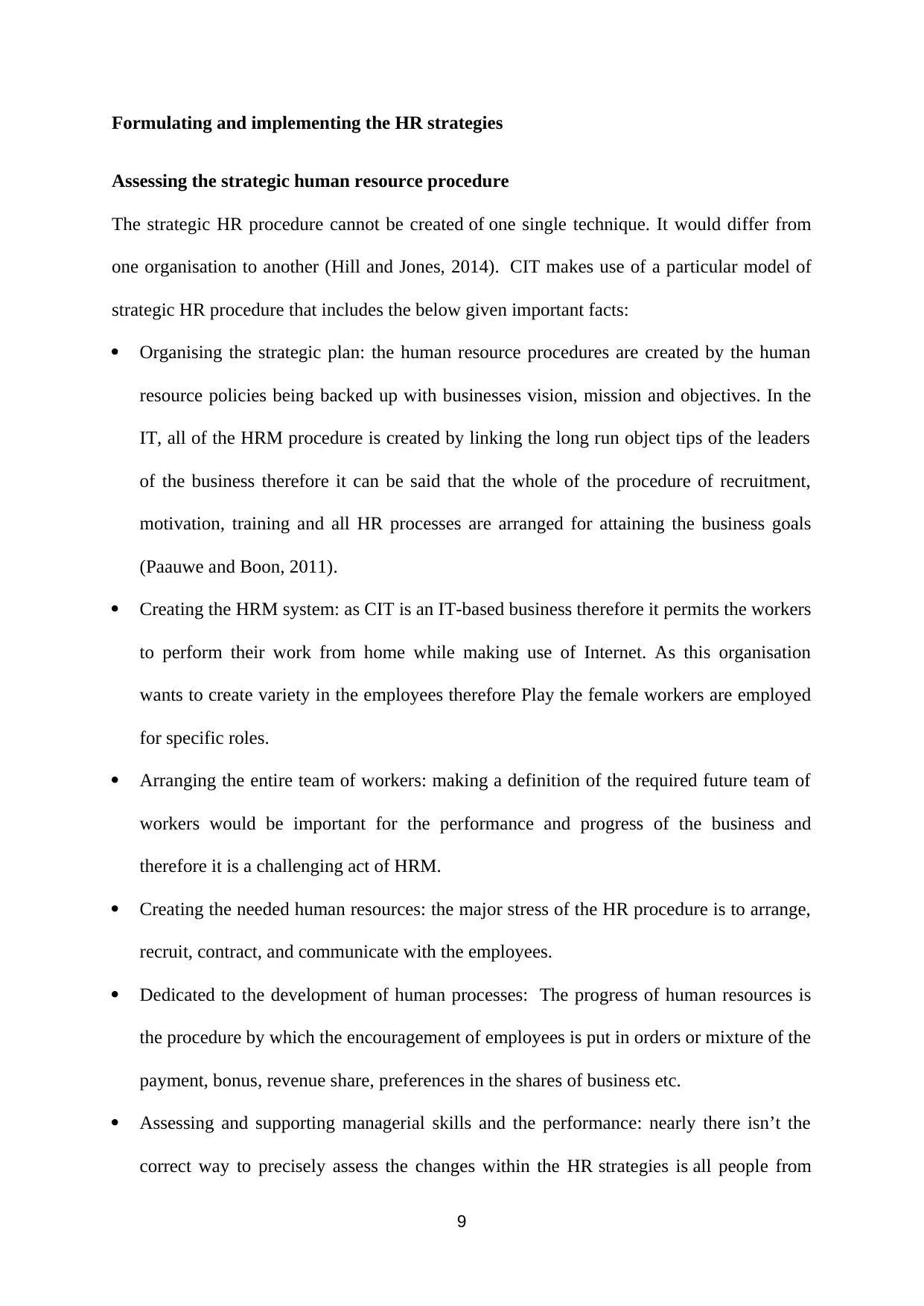
Formulating and implementing the HR strategies
Assessing the strategic human resource procedure
The strategic HR procedure cannot be created of one single technique. It would differ from
one organisation to another (Hill and Jones, 2014). CIT makes use of a particular model of
strategic HR procedure that includes the below given important facts:
Organising the strategic plan: the human resource procedures are created by the human
resource policies being backed up with businesses vision, mission and objectives. In the
IT, all of the HRM procedure is created by linking the long run object tips of the leaders
of the business therefore it can be said that the whole of the procedure of recruitment,
motivation, training and all HR processes are arranged for attaining the business goals
(Paauwe and Boon, 2011).
Creating the HRM system: as CIT is an IT-based business therefore it permits the workers
to perform their work from home while making use of Internet. As this organisation
wants to create variety in the employees therefore Play the female workers are employed
for specific roles.
Arranging the entire team of workers: making a definition of the required future team of
workers would be important for the performance and progress of the business and
therefore it is a challenging act of HRM.
Creating the needed human resources: the major stress of the HR procedure is to arrange,
recruit, contract, and communicate with the employees.
Dedicated to the development of human processes: The progress of human resources is
the procedure by which the encouragement of employees is put in orders or mixture of the
payment, bonus, revenue share, preferences in the shares of business etc.
Assessing and supporting managerial skills and the performance: nearly there isn’t the
correct way to precisely assess the changes within the HR strategies is all people from
9
Assessing the strategic human resource procedure
The strategic HR procedure cannot be created of one single technique. It would differ from
one organisation to another (Hill and Jones, 2014). CIT makes use of a particular model of
strategic HR procedure that includes the below given important facts:
Organising the strategic plan: the human resource procedures are created by the human
resource policies being backed up with businesses vision, mission and objectives. In the
IT, all of the HRM procedure is created by linking the long run object tips of the leaders
of the business therefore it can be said that the whole of the procedure of recruitment,
motivation, training and all HR processes are arranged for attaining the business goals
(Paauwe and Boon, 2011).
Creating the HRM system: as CIT is an IT-based business therefore it permits the workers
to perform their work from home while making use of Internet. As this organisation
wants to create variety in the employees therefore Play the female workers are employed
for specific roles.
Arranging the entire team of workers: making a definition of the required future team of
workers would be important for the performance and progress of the business and
therefore it is a challenging act of HRM.
Creating the needed human resources: the major stress of the HR procedure is to arrange,
recruit, contract, and communicate with the employees.
Dedicated to the development of human processes: The progress of human resources is
the procedure by which the encouragement of employees is put in orders or mixture of the
payment, bonus, revenue share, preferences in the shares of business etc.
Assessing and supporting managerial skills and the performance: nearly there isn’t the
correct way to precisely assess the changes within the HR strategies is all people from
9
⊘ This is a preview!⊘
Do you want full access?
Subscribe today to unlock all pages.

Trusted by 1+ million students worldwide
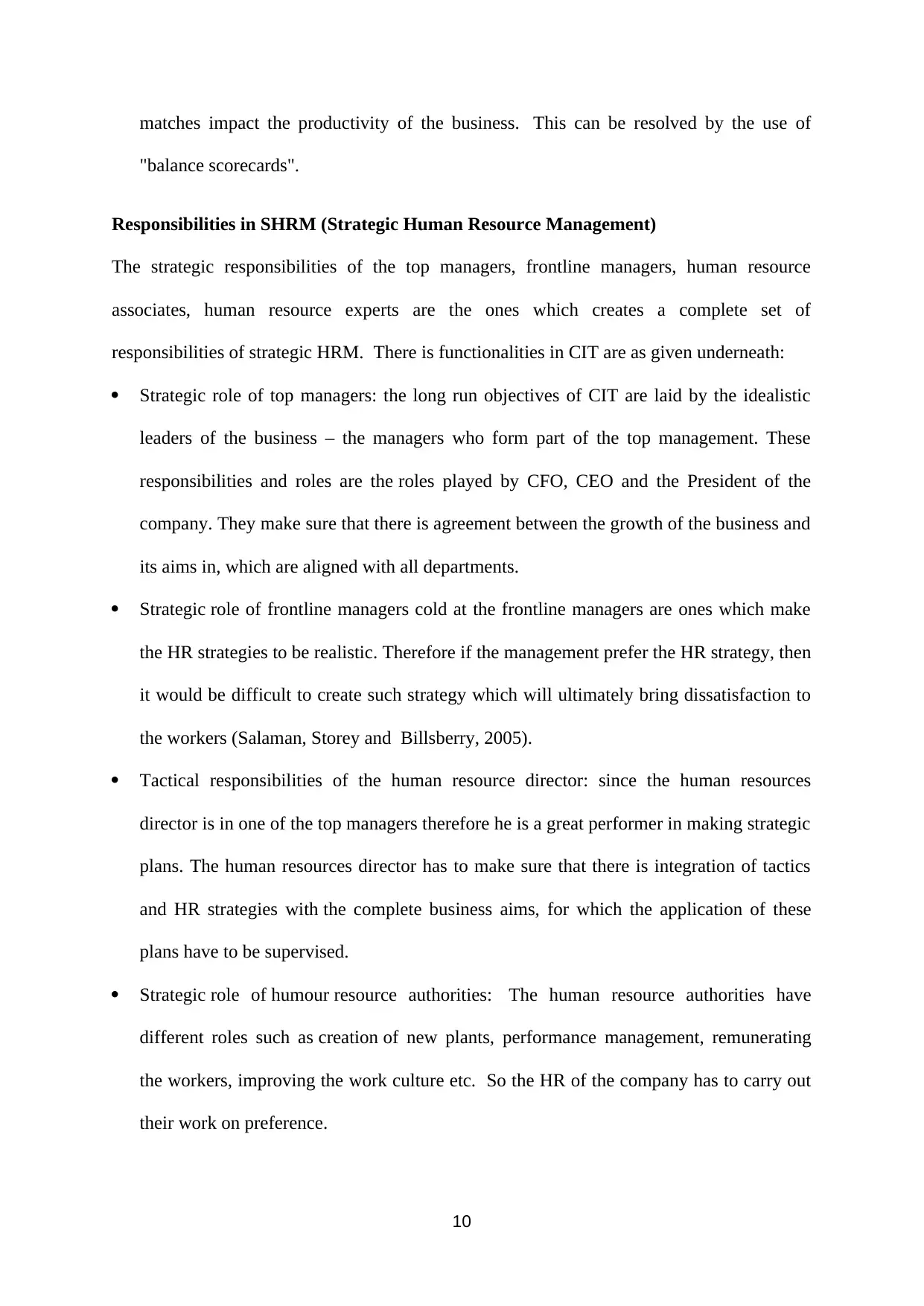
matches impact the productivity of the business. This can be resolved by the use of
"balance scorecards".
Responsibilities in SHRM (Strategic Human Resource Management)
The strategic responsibilities of the top managers, frontline managers, human resource
associates, human resource experts are the ones which creates a complete set of
responsibilities of strategic HRM. There is functionalities in CIT are as given underneath:
Strategic role of top managers: the long run objectives of CIT are laid by the idealistic
leaders of the business – the managers who form part of the top management. These
responsibilities and roles are the roles played by CFO, CEO and the President of the
company. They make sure that there is agreement between the growth of the business and
its aims in, which are aligned with all departments.
Strategic role of frontline managers cold at the frontline managers are ones which make
the HR strategies to be realistic. Therefore if the management prefer the HR strategy, then
it would be difficult to create such strategy which will ultimately bring dissatisfaction to
the workers (Salaman, Storey and Billsberry, 2005).
Tactical responsibilities of the human resource director: since the human resources
director is in one of the top managers therefore he is a great performer in making strategic
plans. The human resources director has to make sure that there is integration of tactics
and HR strategies with the complete business aims, for which the application of these
plans have to be supervised.
Strategic role of humour resource authorities: The human resource authorities have
different roles such as creation of new plants, performance management, remunerating
the workers, improving the work culture etc. So the HR of the company has to carry out
their work on preference.
10
"balance scorecards".
Responsibilities in SHRM (Strategic Human Resource Management)
The strategic responsibilities of the top managers, frontline managers, human resource
associates, human resource experts are the ones which creates a complete set of
responsibilities of strategic HRM. There is functionalities in CIT are as given underneath:
Strategic role of top managers: the long run objectives of CIT are laid by the idealistic
leaders of the business – the managers who form part of the top management. These
responsibilities and roles are the roles played by CFO, CEO and the President of the
company. They make sure that there is agreement between the growth of the business and
its aims in, which are aligned with all departments.
Strategic role of frontline managers cold at the frontline managers are ones which make
the HR strategies to be realistic. Therefore if the management prefer the HR strategy, then
it would be difficult to create such strategy which will ultimately bring dissatisfaction to
the workers (Salaman, Storey and Billsberry, 2005).
Tactical responsibilities of the human resource director: since the human resources
director is in one of the top managers therefore he is a great performer in making strategic
plans. The human resources director has to make sure that there is integration of tactics
and HR strategies with the complete business aims, for which the application of these
plans have to be supervised.
Strategic role of humour resource authorities: The human resource authorities have
different roles such as creation of new plants, performance management, remunerating
the workers, improving the work culture etc. So the HR of the company has to carry out
their work on preference.
10
Paraphrase This Document
Need a fresh take? Get an instant paraphrase of this document with our AI Paraphraser
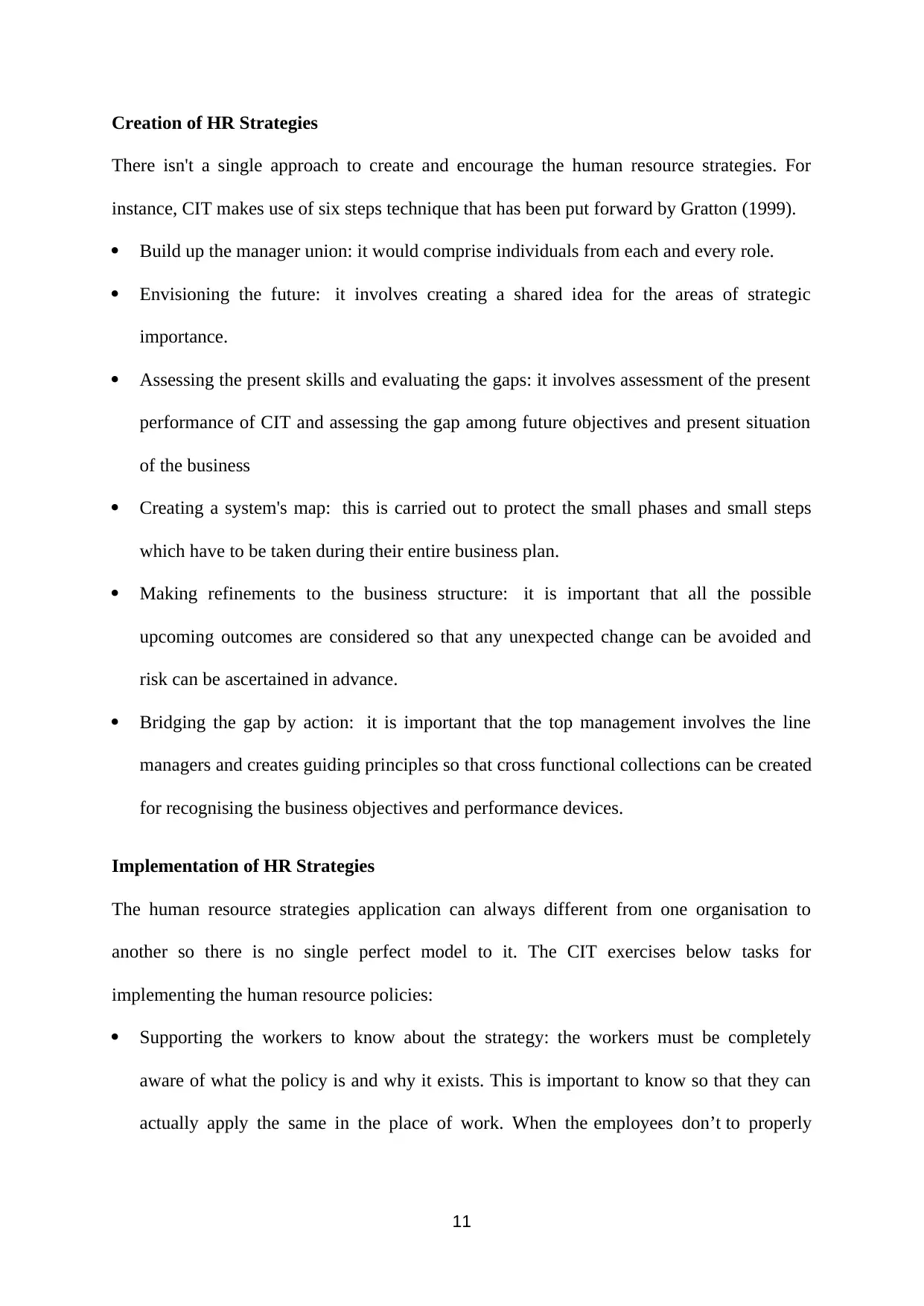
Creation of HR Strategies
There isn't a single approach to create and encourage the human resource strategies. For
instance, CIT makes use of six steps technique that has been put forward by Gratton (1999).
Build up the manager union: it would comprise individuals from each and every role.
Envisioning the future: it involves creating a shared idea for the areas of strategic
importance.
Assessing the present skills and evaluating the gaps: it involves assessment of the present
performance of CIT and assessing the gap among future objectives and present situation
of the business
Creating a system's map: this is carried out to protect the small phases and small steps
which have to be taken during their entire business plan.
Making refinements to the business structure: it is important that all the possible
upcoming outcomes are considered so that any unexpected change can be avoided and
risk can be ascertained in advance.
Bridging the gap by action: it is important that the top management involves the line
managers and creates guiding principles so that cross functional collections can be created
for recognising the business objectives and performance devices.
Implementation of HR Strategies
The human resource strategies application can always different from one organisation to
another so there is no single perfect model to it. The CIT exercises below tasks for
implementing the human resource policies:
Supporting the workers to know about the strategy: the workers must be completely
aware of what the policy is and why it exists. This is important to know so that they can
actually apply the same in the place of work. When the employees don’t to properly
11
There isn't a single approach to create and encourage the human resource strategies. For
instance, CIT makes use of six steps technique that has been put forward by Gratton (1999).
Build up the manager union: it would comprise individuals from each and every role.
Envisioning the future: it involves creating a shared idea for the areas of strategic
importance.
Assessing the present skills and evaluating the gaps: it involves assessment of the present
performance of CIT and assessing the gap among future objectives and present situation
of the business
Creating a system's map: this is carried out to protect the small phases and small steps
which have to be taken during their entire business plan.
Making refinements to the business structure: it is important that all the possible
upcoming outcomes are considered so that any unexpected change can be avoided and
risk can be ascertained in advance.
Bridging the gap by action: it is important that the top management involves the line
managers and creates guiding principles so that cross functional collections can be created
for recognising the business objectives and performance devices.
Implementation of HR Strategies
The human resource strategies application can always different from one organisation to
another so there is no single perfect model to it. The CIT exercises below tasks for
implementing the human resource policies:
Supporting the workers to know about the strategy: the workers must be completely
aware of what the policy is and why it exists. This is important to know so that they can
actually apply the same in the place of work. When the employees don’t to properly
11
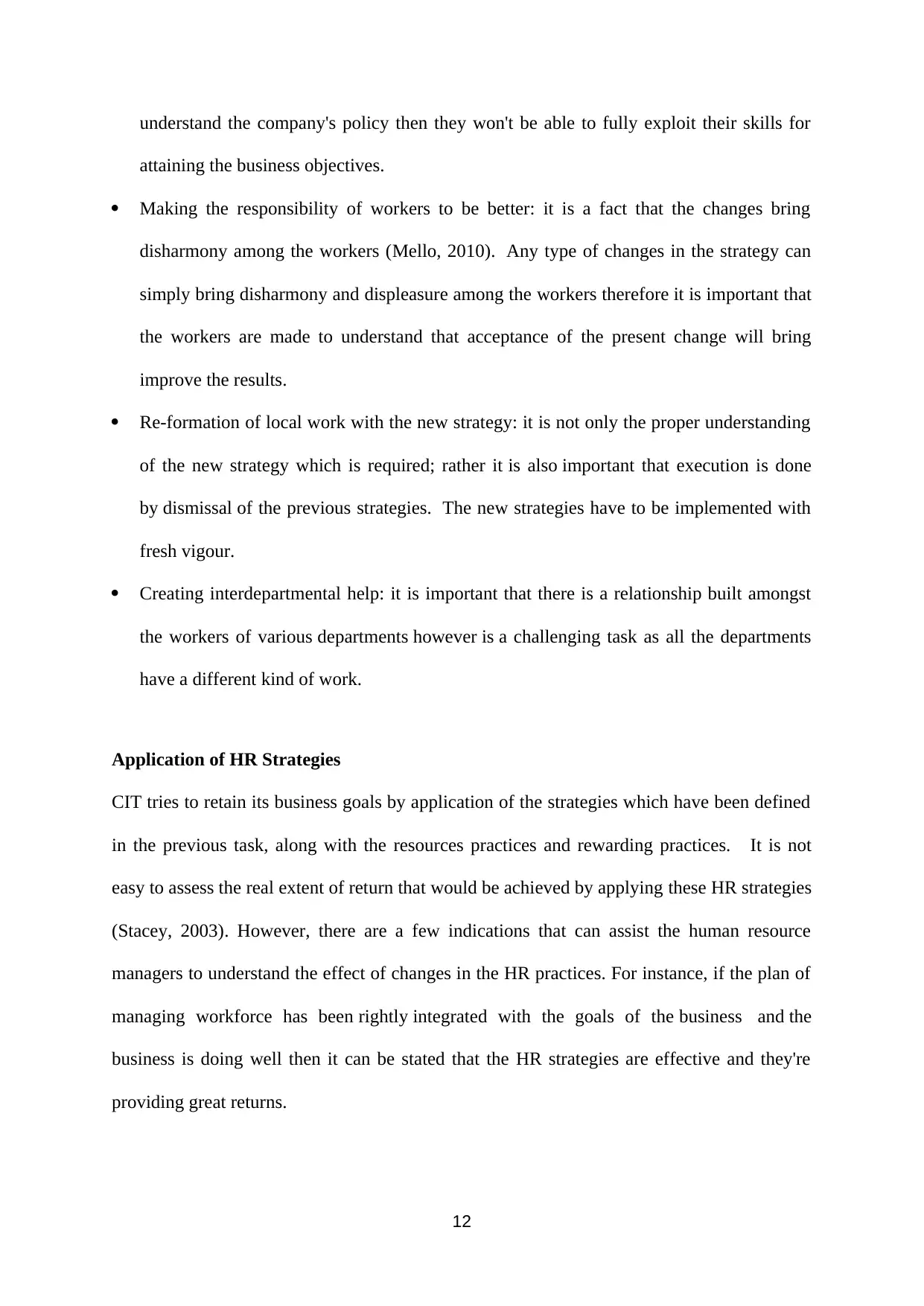
understand the company's policy then they won't be able to fully exploit their skills for
attaining the business objectives.
Making the responsibility of workers to be better: it is a fact that the changes bring
disharmony among the workers (Mello, 2010). Any type of changes in the strategy can
simply bring disharmony and displeasure among the workers therefore it is important that
the workers are made to understand that acceptance of the present change will bring
improve the results.
Re-formation of local work with the new strategy: it is not only the proper understanding
of the new strategy which is required; rather it is also important that execution is done
by dismissal of the previous strategies. The new strategies have to be implemented with
fresh vigour.
Creating interdepartmental help: it is important that there is a relationship built amongst
the workers of various departments however is a challenging task as all the departments
have a different kind of work.
Application of HR Strategies
CIT tries to retain its business goals by application of the strategies which have been defined
in the previous task, along with the resources practices and rewarding practices. It is not
easy to assess the real extent of return that would be achieved by applying these HR strategies
(Stacey, 2003). However, there are a few indications that can assist the human resource
managers to understand the effect of changes in the HR practices. For instance, if the plan of
managing workforce has been rightly integrated with the goals of the business and the
business is doing well then it can be stated that the HR strategies are effective and they're
providing great returns.
12
attaining the business objectives.
Making the responsibility of workers to be better: it is a fact that the changes bring
disharmony among the workers (Mello, 2010). Any type of changes in the strategy can
simply bring disharmony and displeasure among the workers therefore it is important that
the workers are made to understand that acceptance of the present change will bring
improve the results.
Re-formation of local work with the new strategy: it is not only the proper understanding
of the new strategy which is required; rather it is also important that execution is done
by dismissal of the previous strategies. The new strategies have to be implemented with
fresh vigour.
Creating interdepartmental help: it is important that there is a relationship built amongst
the workers of various departments however is a challenging task as all the departments
have a different kind of work.
Application of HR Strategies
CIT tries to retain its business goals by application of the strategies which have been defined
in the previous task, along with the resources practices and rewarding practices. It is not
easy to assess the real extent of return that would be achieved by applying these HR strategies
(Stacey, 2003). However, there are a few indications that can assist the human resource
managers to understand the effect of changes in the HR practices. For instance, if the plan of
managing workforce has been rightly integrated with the goals of the business and the
business is doing well then it can be stated that the HR strategies are effective and they're
providing great returns.
12
⊘ This is a preview!⊘
Do you want full access?
Subscribe today to unlock all pages.

Trusted by 1+ million students worldwide
1 out of 21
Related Documents
Your All-in-One AI-Powered Toolkit for Academic Success.
+13062052269
info@desklib.com
Available 24*7 on WhatsApp / Email
![[object Object]](/_next/static/media/star-bottom.7253800d.svg)
Unlock your academic potential
Copyright © 2020–2025 A2Z Services. All Rights Reserved. Developed and managed by ZUCOL.




